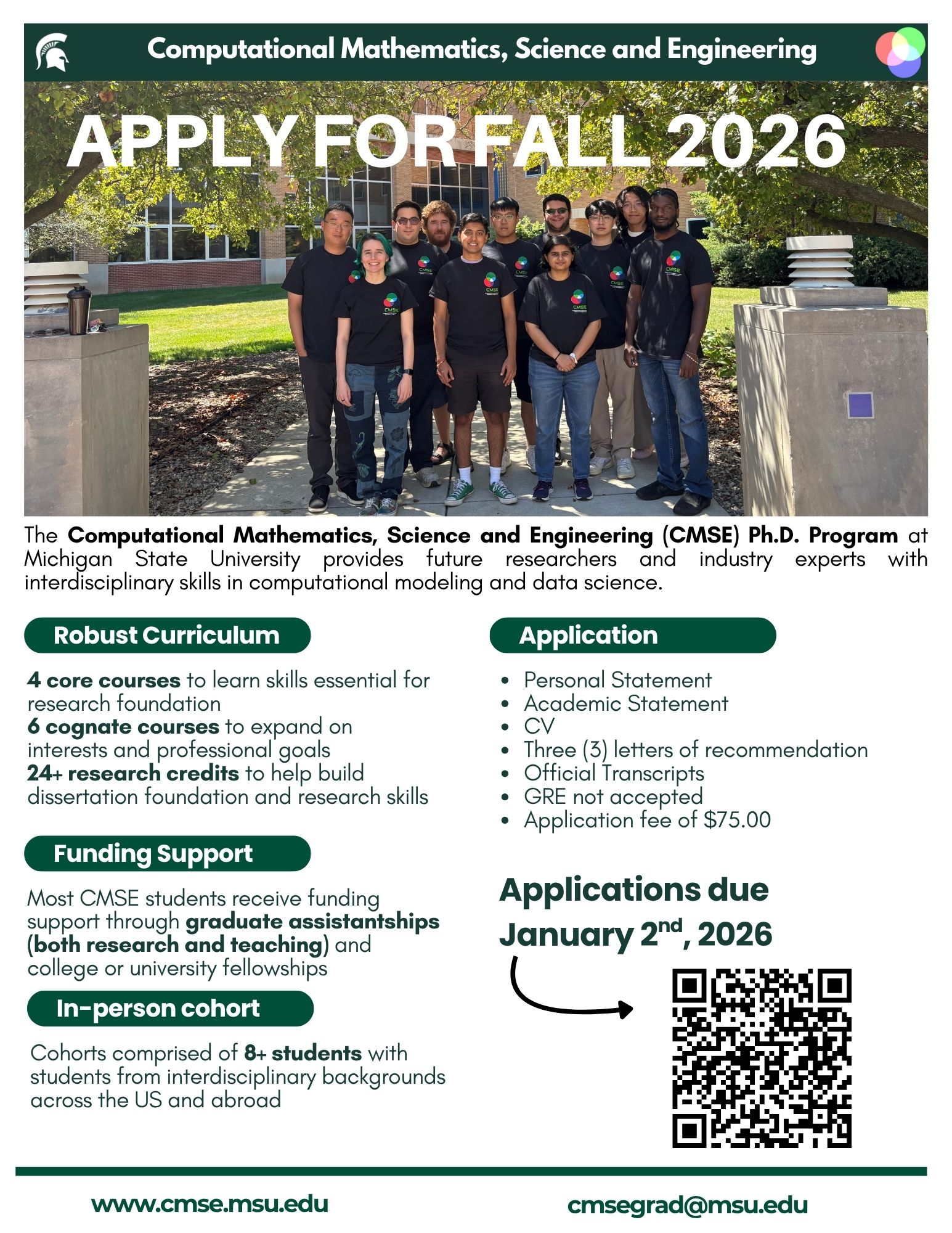Dissertation Defense of CMSE Thomas Chuna
Department of Computational Mathematics, Science & Engineering
& Department of Physics and Astronomy
Michigan State University
Dissertation Defense Notice
Thomas Chuna
March 22, 2024
9:00 am
428 S. Shaw Lane, room 1234
Engineering Building
-or-
Zoom Meeting ID: 706 874 4341
“Multi-Species Dynamic Response and Kinetic Phenomena in High Energy Density Plasmas”
Abstract:
High energy density (HED) science, concerned with matter at pressures in excess of 1 MBar, investigates the processes occurring inside nuclear fusion and giant planets, enhancing our understanding of the universe's most energetic events. This work contains three primary results. First, we incorporate conservation of momentum into the collisional multi-species dynamic response models. Second, we extend the single species hybrid kinetic-fluid model of Degond et al. [Degond, Pierre, Shi Jin, and Luc Mieussens. JCP 209.2 (2005): 665-694] to multi-species. Third, we present data-driven observations of system equilibration, which can assess the quality of machine-learned model closures in extended moment hydrodynamics. Each result uses expansions about equilibrium, but contributes to HED science in different ways.Measuring the material properties of HED matter is challenging since they exist for a short time in a confined space at conditions that damage nearby equipment. Thus, experimental diagnostics rely on scattered and emitted electromagnetic spectra to investigate material properties. Connecting the spectra to material properties requires theoretical models of dynamic response. Typical dynamic response models include the Mermin model, predicting Drude-like conductivity [Mermin, N. David. PRB 1.5 (1970): 2362], and the Drude-Smith model, predicting non-Drude-like conductivity [Smith, N. V. PRB 64.15 (2001): 155106]. However, the often used Mermin model of dynamic response does not satisfy the relevant sum rules, and the Drude-Smith model lacks interpretability. In this dissertation, we include number and momentum conserving multi-species collisions to develop a new dynamic dielectric function for multi-species plasmas which satisfies relevant sum rules. We demonstrate the impact of each conservation law on the predicted dynamic structure factor of a pure deuterium-tritium (DT) HED plasma as well as a carbon contaminated (DT) HED plasma. Additionally, we present a new dynamic non-Drude conductivity model that has a clear interpretation. Comparing our conductivity model to the Drude-Smith conductivity model, we conclude that Smith’s intensely debated phenomenological parameter violates local number conservation.Simulations are conducted to complement and inform HED experiments. Historically, HED scientists have used radiation–hydrodynamic codes. However, Eulerian codes assume the mean free path in the plasma is infinitesimally small, placing the system in local equilibrium. This assumption neglects dissipation and forces species in the same location to share a bulk velocity and temperature. Current codes correct for dissipation, which improves predictions, but they cannot correct for velocity and temperature separation. A fully kinetic code could account for these phenomena, but such a code is computationally infeasible for realistic 3D simulations. In this dissertation, we present a hybrid model which can smoothly transition between Haack et al.'s multi-species kinetic PDE [Haack, Hauck and Murillo, J. Stat. Phys. 168, 4] and multi-species hydrodynamic PDEs. We validate the hybrid model on the Sod shock problem and then investigate multi-species mixing in HED experiments. Within our simulation, we identify electro-diffusion at the interfaces as well as persistent velocity and temperature separation between species, phenomena that are missed by purely hydrodynamic codes.As an alternative to hybrid models, extended moment hydrodynamic models can be employed [Hoffman, Nelson M., et al. Physics of Plasmas 22.5 (2015)]. However, to close the hierarchy of moments, these models often assume local equilibrium. Machine learning is an emerging approach to the moment closure problem, which can avoid such assumptions. We construct a complex-valued, multi-step neural network to close Grad's extended moment equations [Grad, Harold. Comm. pure and applied mathematics 2.4 (1949): 331-407]. Additionally, the quality of a closure is typically assessed in terms of its ability to describe diffusion/dissipation and its long-time stability. We use dimension reduction techniques and dynamic mode decomposition to observe the equilibration process. This collection of data-driven techniques provides new metrics to assess a neural network's ability to inform on dissipation.
COMMITTEE:
Michael Murillo, chairperson
Metin Aktulga
Wade Fisher
Brian O’Shea
Scott Pratt
Thesis is available at https://pa.msu.edu/academics/graduate-program/current-graduate-students/draft-dissertations-for-review/ - Select student name



